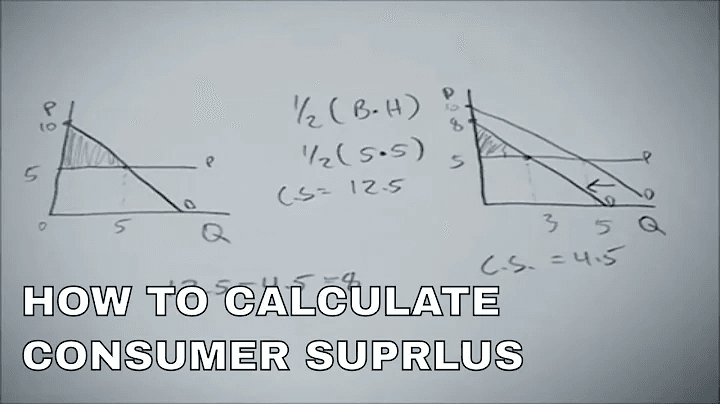In the field of economics, customer profit is an essential factor for studying consumer gain from the acquisition of goods and services. The specificity of this apparently woolly-sounding economic slogan is, in fact, far from meaningless. If you’ve ever labelled something in your portfolio as something other than what you wanted it to be when you first agreed to buy it, then you’ve ever experienced consumer surplus. In this article, we will discuss what consumer surplus is, how to compute for it using the consumer surplus formula, and why this concept is important to the business entities, the consumers and the policy makers.
What is Consumer Surplus?

Consumer surplus, is the amount by which price Consumers are willing to pay for a good or service exceeds the price actually paid. Basically, it determines the worth that consumer gets when buying a product at a price below the maximum amount they are willing to spend.
Example of Consumer Surplus:
For instance, suppose you are looking for a new smartphone. You are willing to spend up to $1000 for it, and then you discover that the phone is on sale at $750. Consumer surplus is determined by $250 subtracting the price you are actually willing to pay from the price you are willing to pay.

It can be used to any good or service that you wish to develop and bring to market. In a broader perspective, consumer surplus gives the extent of benefit consumers get from what they consume.
The Consumer Surplus Formula

The formula for calculating consumer surplus is relatively simple and is derived from the demand curve in economics:
According to the consumer’s point of view the CSC can be calculated as CS = 0.5 x (MWP – MP) x Q CS= 12 x (MWP-MP) x Q Consumer Surplus = 21*(Maximum Willingness to Pay – Market Price) * Quantity Purchased
This formula rests on the assumption that the demand curve is linear so that the area under this curve can be computed much easier.
Breaking Down the Formula:

- Maximum Willingness to Pay: The maximum amount of money a consumer is ready, willing and able to spend for a particular good or service.
- Market Price: The cost at which an actual good or service is sold to consumers in that particular market or being offered by the company.
- Quantity Purchased: The quantity of the product that is purchased by the consumer.
In other words consumer surplus can be regarded as the area of a triangle that may exist between the demand curve on one hand and price consumers pay, on the other hand over a given quantity.
Graphical Representation:

Generally in economic diagrams, the consumer surplus is illustrated by the shaded area between the demand curve, and the price level located above the equilibrium price but below the demand curve.
Understanding the Demand Curve and Consumer Surplus

The demand curve is one of the critical elements of a supply chain management strategy that relate the price of a good to the quantity demanded. Most of the time the demand curve is downward sloping from the graph meaning that when prices tending to reduce there is a corresponding tendency for quantity demanded to do the same.

The area of consumer surplus on a graph is the area between the actual price that the consumer pays and the price at which the consumer is willing to buy the product but which is paralleled by the demand curve. In other words, the higher the slope of the demand curve the higher the level of consumer surplus.
Consumer Surplus in Real Markets:
- Perfect Competition: Perfect competition operates at market price that is arrived at through the union of the demand and supply curve.. In general, consumer surplus is at the highest level because consumers can acquire products at the lowest price range.
- Monopolies: A monopoly is a market structure in which the single supplier has the ability to choose prices above that of the competitive equilibrium, although the consumer surplus is affected in this market structure. The extent of consumer surplus is even lower because few other goods or services can be substituted in the event of a monopoly price.
Consumer Surplus Example: Detailed Calculation

Now let us try to illustrate consumer surplus by working through a basic example of a market. Assume the demand for a particular product is represented by the equation:
Q=100−2PQ = 100 – 2PQ=100−2P
Where:
- QQQ is the quantity demanded
- PPP is the price
Now, suppose the product is being sold for $20 per unit. To calculate consumer surplus, we first need to determine the maximum willingness to pay by setting Q=0Q = 0Q=0:
0=100−2P0 = 100 – 2P0=100−2P P=50P = 50P=50
So, the maximum price consumers are willing to pay is $50. Now, we can calculate consumer surplus using the formula:
Consumer Surplus=12×(50−20)×60\text{Consumer Surplus} = \frac{1}{2} \times (50 – 20) \times 60Consumer Surplus=21×(50−20)×60
Where:
- Maximum WTP = 50$
- Market Price = $20
- Quantity Purchased (QQQ) is calculated by plugging P=20P = 20P=20 into the demand equation: Q=100−2(20)=60 60atic]] Thus the price elasticity of demand, Q, when price P is $20 is 60 Qatar.
Thus, the consumer surplus is:

Consumer Surplus=12×30×60=900\text{Consumer Surplus} = \frac{1}{2} \times 30 \times 60 = 900Consumer Surplus=21×30×60=900
Therefore, in this market, the consumer surplus is $900.
Factors Affecting Consumer Surplus

Several factors can influence consumer surplus:
- Price Changes: Consumers in any market undergo changes in their consumer surplus due to a change in the price of a particular product. Whenever price drops consumer surplus is high, while in circumstances where the price rises, consumer surplus is low.
- Availability of Substitutes: Substitutes make it such that consumers have more choices to chose from, thus a higher consumer surplus. On the other hand, where substitutes are few, there has been a decrease in consumer surplus.
- Income Levels: When consumers earn more money they might be willing to spend more money for particular products, which can further increase the consumer surplus in those markets that relay in luxury or inessential products.
- Technological Advancements: Technological advancement and innovation decreases the cost mainly because it makes it possible for the consumers to buy product at cheaper prices. This could increase the consumer surplus as consumers are the ones who will benefit from the price cut.
Importance of Consumer Surplus in Economics

Consumer surplus refers to this area in a number of ways within different aspects of economic theory and practice. Here are a few reasons why it matters:
- Measuring Economic Welfare: Consumer surplus can be measured and is extensively used as a proxy to measure economic welfare or well-being. It demonstrates just how much consumers gain through their participation in the existing market; it is a measure of efficiency of resource use.
- Policy Implications: They develop consumer surplus in order to measure the repercussions of taxation or subsidies, and controls or coercions that may affect consumers. For instance a tax that increases price and decreases consumer surplus means a negative effect on consumers.
- Pricing Strategies: Some of keywords that are used frequently by businesses especially in the determination of prices include consumer surplus. Pricing strategies are most effectively implemented when firms are able to determine the highest willingness of a consumer hence the need for the willingness concept in companies.
- Market Efficiency: In competitive markets, the consumer surplus has more to do with efficiency or lack of it in the given markets. High levels of consumer surplus imply consumers are benefiting from low prices, while low levels of consumer surplus suggest the presence of inefficiencies such as monopoly prices or failures such as lack of competition.
Consumer Surplus vs. Producer Surplus

In economics, there’s also what is called producer surplus or the amount of money that a producer gains from selling a good at a price higher than what he or she would charge. Therefore, consumer rent plus producer rent gives the over-all economic rent of a market place.

The situation where both consumers and producers are getting the most from this trade is known as the conditions of highest efficiency.
Conclusion: Why Consumer Surplus Matters
Consumer surplus is one of the commonly used measures of consumer’s well-being as well as the efficiency of the markets. It offers information on much utility consumers get out of market exchange and assists in the formulation of policies by organisations such as businessmen, governments and evaluation of economic concepts like demand and supply. Taking into consideration the consumer surplus makes it easier to assess the effects which the alterations in price, market structures and public policies make on consumers.




